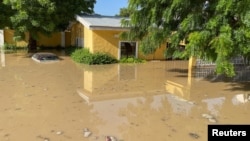Flood water from an overflowing dam has destroyed thousands of homes in Maiduguri, the capital city of Borno state in northeast Nigeria, and emergency officials fear the situation could get worse.
Several aerial videos and photos shared by the National Emergency Management Agency (NEMA) with AFP showed rows of houses submerged in murky water.
An epicenter of more than a decade-long insurgency, Maiduguri serves as the hub for the responses to the humanitarian crisis in the northeast region.
The United Nations refugee agency in Nigeria on its X account said it was the city’s worst flooding in 30 years.
“It is an unprecedented incident,” NEMA spokesman Ezekiel Manzo told AFP on Tuesday. “Some of the central parts of the city that have not witnessed flood in so many years are witnessing it today.”
Thousands of homes have been submerged by the rapid rise of water after the rupture of the Alau Dam on the Ngadda River, 20 kilometers (12 miles) south of Maiduguri.
“The last three days have over 150,000 individuals with over 23,000 households affected,” said NEMA zonal coordinator Surajo Garba.
But with more locations being hit, “we are sure the figure will be much over 200,000 individuals,” Garba forecast.
“The flood, which began over the weekend and worsened in the following days, was the direct result of excess water from the Alau Dam,” said Nigeria’s Vice President Kashim Shettima, who hails from Maiduguri, as he visited the area.
“The collapse of the spillways unleashed a significant surge of water downstream, causing widespread flooding in the surrounding communities,” Shettima said.
The flood also inundated the city’s post office and main zoo, with authorities warning that deadly animals had been washed into communities.
Manzo said forecasts did not prepare the emergency workers for the extent of the flooding, while also blaming the impact of climate change for the disaster.
He told AFP there were deaths from the incident but declined to give a specific number because rescue workers continue rescue operations in the affected areas.
With flooding still high in many parts of the city, authorities have opened three temporary shelters for the victims.
“Homes are submerged, schools shut down and businesses crippled as people evacuate with their belongings,” the U.N. High Commissioner for Refugees’ Nigeria office said.
Floods have killed at least 229 people and displaced around 380,000 more in parts of the country, according to NEMA, but mainly in the northern region.
Some 110,000 hectares (280,000 acres) of farmland have also been affected, NEMA figures showed.
Damage to farmland will worsen Nigeria’s high rates of food insecurity, Save the Children warned last week.
“One in every six children across Nigeria faced hunger in June-August this year” – a 25% increase on the same period last year, the NGO said in a statement.
Flooding, usually caused by abundant rains and poor infrastructure, has caused large-scale destruction in Africa’s most populous country in the past.
More than 360 people died and more than 2.1 million were displaced in 2012.
In 2022, more than 500 people died and 1.4 million were displaced in the worst floods in a decade.
Nigeria’s President Bola Ahmed Tinubu offered his “condolences” to those affected in a statement, “especially to the families that have lost their means of livelihood due to the disaster.”
His office said earlier he is working with state authorities to “address the immediate humanitarian needs of the affected people.”



